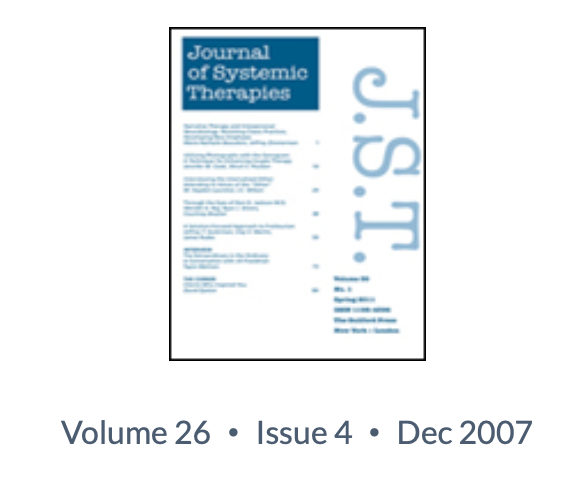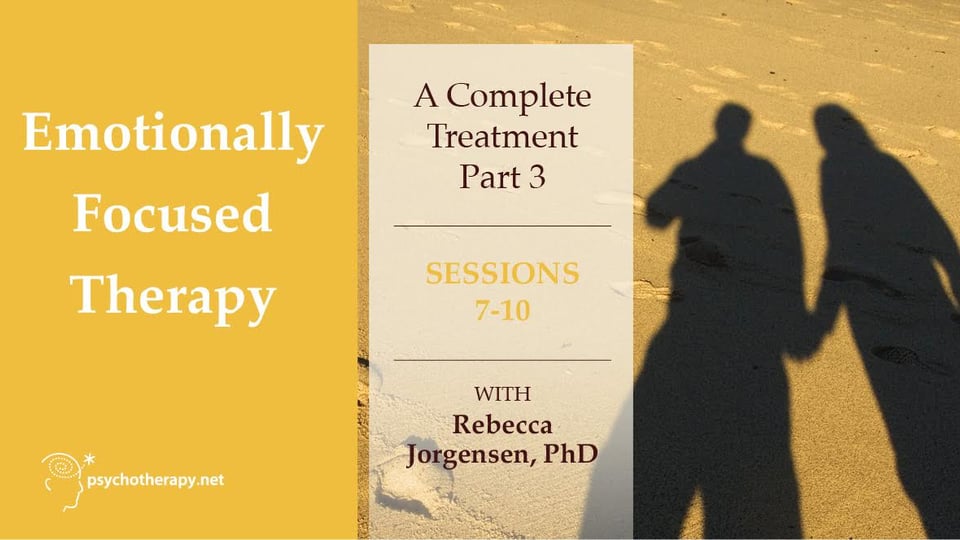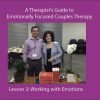The Psychology of Pursuers:
In today's lesson we will look at the inner world of the person in a relationship who most actively pursues more closeness and connection with their partner. In EFT language we call this person "the pursuer". Although both partners in a relationship may feel disconnected to some extent, it is often the pursuer who is most adamant about doing something about it or addressing the issue. It is therefore often the pursuer who leads the charge to schedule a couples therapy session and most openly expresses dissatisfaction about the relationship.
Lesson 5: What You will Learn in Today's EFT Lesson...
- The main strategies a pursuer uses to manage their feelings of loneliness and rejection
- How to work with pursuers in Stage 2 of EFT
- How to resolve the distress of the pursuer through novel ways of communicating
- How to achieve the main change events of Blamer Softening and Withdrawer Re-engagement
The Psychology of Pursuers:
The pursuer is the person in a relationship who does not feel enough of a connection with their partner and ends up experiencing primary emotions of sadness/ loneliness/ isolation, or fears about how much they really mean to their partner and fears of being left or abandoned. To understand the psychology of the pursuer a little bit better, read EFT trainer Brent Bradley’s chapter: Seeing through Pursuing Eyes. (Chapter 9)
The pursuer in a relationship feels a painful and intolerable absence of affection, connection, friendship, or stimulation. This creates feelings of separation distress, isolation, pain, loneliness, and unfulfilled yearnings and, even deeper down, a fear that they are really truly alone in the world. This is scary and unsafe because it means that they have no one to depend on or truly be there for them.
The Strategies of a Pursuer:
The pursuer has several choices of how to deal with this unsatisfactory state:
1. They can try to close the gap between themselves and their partner by working hard to make their partner more interested in them. Sometimes this takes the shape of putting their partners needs and feelings first, putting effort into their appearance, trying to be lenient, compassionate, and understanding, or trying to reform aspects of themselves which they think their partner doesn't like about them. Later, when the pursuer realizes this doesn't necessarily fix the problem this might be thrown back in the withdrawer’s face as: “I’m the only one who puts effort into this relationship...” Or it can build resentments: “I bend over backwards to try to make you happy and you can’t even do one little thing for me...”.
2. They can externalize the blame by becoming critical of their partner for being insensitive, selfish, or unloving
3. They can try to change their partner into being the lovable or attentive person they want them to be or come up with rules about ways the partner can prove their love (“I need you to take me on dates more often" or "if you care about me you won’t go out with your friends tonight”)
4. They can get stuck in shame/ worthlessness about their own lovability: “Am I really that hard to love? Is it because I am too needy or too much that I can’t interest my partner?”
5. They can feel helpless to change the status quo of the relationship and resign themselves to not get their needs met. This might also show up as the pursuer finding meaning and connection elsewhere such as with friends. Their partner might even encourage this as it frames the loneliness and disconnection as an issue the pursuer can solve on their own and not a relationship issue. However, meaning and connection elsewhere is not a substitute for meaning and connection in an intimate relationship so framing the issue this way may inadvertently further the disconnection and hasten the demise of the relationship. The pursuer may be left with no option but to mourn the relationship and stop trying to make things work (In EFT we call this a burnt-out pursuer).
6. They can threaten to leave and find the missing love, connection, friendship, and stimulation somewhere else (“if you go out one more time, we are finished”).
The Hidden Need of the Pursuer:
Deep down, however, regardless of the way the pursuer tries to solve their dilemma, the pursuer has a need to feel more loved, more closely connected, more indispensable, and ultimately to feel safe that their partner won’t leave them and can truly be depended on to be there for them no matter what. This assuages their existential or attachment fear that they could find themselves utterly alone in the world, without any love, or without mattering to anyone, or that they are fundamentally unlovable.
Working with Pursuers and Withdrawers in Stage 2 of EFT:
In stage 2 of EFT both the pursuer and the withdrawer (one at a time) are invited to go deeper into the fears that cause them to pursue or withdraw. First step in doing so is to acknowledge that they have a fear, which they should already be aware of as a result of having understood the ins and outs of their negative cycle (stage 1).
Step 5:
In stage 2, however, both the pursuer and the withdrawer are not simply asked to acknowledge that they have fears that make them pursue or withdraw, but to stay in the experiential awareness of their fear long enough to begin to talk about it openly and really own it as part of their life story. Rather than just hide the fear away, keep the fear to or from themselves, or react to the fear by engaging in behaviors such as attempting to control their partner, shutting down, going into their head, or getting angry and critical, partners are helped to stay in the fear, explore the fear, examine the childhood origins of the fear, and thus for the first time maybe claim it openly as part of who they are and what they have been through in life. This deepening exploration of the attachment fears that were only briefly identified and acknowledged in stage 1, is the goal of step 5 in stage 2.
Step 6:
As partners begin to openly acknowledge, identify with, and share their deeply held vulnerable beliefs or fears about their own worth, lovability, and deficits, or the risks about leaning on and getting close to others, they are revealing aspects of themselves that make them feel very vulnerable and unprotected in front of their partner. The goal of step 6 is therefore to help the vulnerable partner get the new corrective emotional experience that sharing these personal secrets leads their partner to feel closer to them, and not turn away in disgust or judge them as weak, childish, or unworthy of love.
Step 7:
Finally as each partner’s fears are shared and no longer need to be defended against or suppressed, each person naturally becomes more aware of what they really need deep down from their partner. A person who begins to acknowledge and experience that they are thirsty, for example, naturally gets in touch with their need to have a drink of water. Similarly, a person who begins to acknowledge and experience their fear of not being good enough or their fear that their partner will leave them, naturally gets in touch with the need to feel valued or the need to get assurance that they are loved. The goal of step 7 is thus to reach trough the inhibiting fear into the clear awareness of the need and anti-dote to the fear and then to have each partner communicate this need directly rather than in a round-about, indirect, or defensive way. This final step in stage 2 is considered to be a necessary milestone for EFT therapy to be considered successful, and is considered a key change event.
Blamer Softening and Withdrawer Re-Engagement:
In stage 2, step 5-7 often naturally melt into each other as they are part of one and the same movement of uncovering and expressing each partner’s true needs that have been hidden underneath their inhibiting or shameful fears. When this process of getting in touch with fears that inhibit the direct expression of needs is completed with the pursuer it is referred to as the change event of Blamer Softening, and when it is completed with the withdrawer it is referred to as Withdrawer Reengagement. As a general rule, it is recommended to first go through steps 5-7 with the withdrawer so as to make the withdrawer more emotionally available before asking the pursuer to trust the withdrawer with their deeper fears and longings.
For the pursuer, blamer softening is accomplished when the pursuer is helped to go through step 5-7 in stage 2 and is finally able to understand and communicate their underlying attachment fears and longings in a direct and vulnerable way without the defensive cover-up of secondary emotions or criticisms.
Read Brent Bradley and James Furrow’s seminal text on the steps and considerations that culminate in Blamer Softening:
Read: Inside Blamer Softening: Maps and Missteps

Video: Working With Pursuers in Stage 1
If you want to learn more about the psychology of pursuers and how to work with their anger in stage 1, I recommend watching EFT trainer George Faller’s video: Highly Escalated Pursuers with George Faller (42:35)
Watch: Working with Anger and Highly Escalated Couples in EFT
EFT in Action:
To watch how to work with blamer softening in stage 2, let’s continue to watch Rebecca Jorgensen’s work with Carl and Sandra.
In session 7 the couple shows signs of cycle de-escalation as evidenced by more optimism about their relationship and more effectiveness in sidestepping arguments. This clears the way for transitioning into stage 2 because partners are now available and able to be responsive to hearing about each person’s deeper fears about self and others.
Rebecca can now help facilitate the process of going deeper into each person’s disowned or suppressed fears (step 5). Because they trust each other more they can now turn to their partner for help with these fears rather than keep them concealed from their partner as some “dirty little secret” that feels too embarrassing or risky to share (step 6).
Mastering step 6 gives them a new way to deal with their fears when they come up. Instead of pushing their fears away, either by becoming angry (pursuer) or shutting down and becoming silent (withdrawer), they can now turn to their partner and get their partner to help them with their fears.
This repositions the partner as someone who can accept me for who I am "warts and all" and proves that the relationship can be a source of support and comfort when I feel most vulnerable. This experience of being able to count on the other person when I feel most afraid or doubtful about myself becomes an anti-dote to the belief that my relationship is tentative and would break if my partner really knew me. This experience of the relationship as a "safe haven" that is able to contain and care for all parts of me, reduces the experience of aloneness and decreases the attachment distress that leads to negative attachment behaviors (critical pursuit, abandoning withdrawal).
By practicing turning to each other with their fears and getting a positive calming or reassuring response back, emotional equilibrium is restored, and each partner is free to be playful and joyful in the world.
Successful completion of stage 2 reinforces the positive feedback loop in the attachment feedback loop we introduced in lesson 1. The answer to the question: “Is the caregiver near, attentive, responsive, etc.?” is now “yes!” and separation distress and anxiety now no longer linger and produce the negative attachment behaviors that previously got the couple stuck in their negative cycle. The couple has learned to co-regulate their anxieties rather than react to their anxieties by treating the other person as the "enemy".

In session 8, Rebecca works with Carl to help him go through step 5-7 and become a more engaged withdrawer. This helps Sandra emotionally understand that Carl is not simply cold towards her or uninterested in her when he goes silent, stops sharing, or tip toes around her. Instead he is dealing with his own fears about how Sandra feels towards him and about what will happen if he continues to fail at making her happy. This then sets the stage, for Rebecca to help Sandra reveal her fears. Having made Carl more available again, it is no longer as scary for Sandra to share her fears and needs since she now feels more held and less abandoned. This is why withdrawer reengagement is often a precondition for blamer softening, since the pursuer needs to first feel that they can count on and lean on their partner, before it makes sense for them to let their partner in on their deepest fears.
Midway into session 9 (3 hr 06 min), Rebecca helps Sandra get more in touch with her deeper relationship fears and negative view of her own lovability (her fear that she is a "monster"). Sandra’s fear becomes live in the room as Carl tells her that he feels loved by her (ie. does not see her as a monster). This then becomes the starting point for a deeper exploration and understanding of the fears Sandra has about depending on someone else for love, and trusting that someone else will see something good in her or something lovable in her. Interestingly, Sandra’s great need to feel lovable and worthwhile briefly overrides her fear that she is not lovable right at the moment when Carl provides the antidote (reassurance that he finds her valuable and needs her), proving that the need for love trumps the fear of love.
In session 10 (4 hr 30 min), Rebecca comes back to an exploration of Sandra’s fears about getting too close to Carl. This fear comes up in the context of Sandra sometimes needing space from Carl because she feels engulfed.
Stay Tuned for the Next Lesson:
Follow us for the next part of our guide to EFT couples therapy when we explore the subjective experience and psychology of the "withdrawer" - the other half of the pursuer/ withdrawer dynamic that leads most couples to therapy...




























